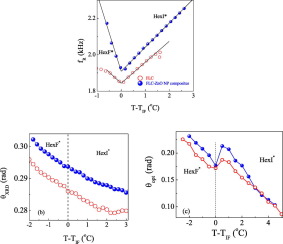Journal of Molecular Liquids ( IF 6 ) Pub Date : 2020-01-16 , DOI: 10.1016/j.molliq.2020.112508 K.L. Sandhya , N. Pushpavathi , D.S. Shankar Rao , S. Krishna Prasad

|
We report the influence of a very small concentration (0.1 wt%) of ZnO nanoparticles (NPs) on the dielectric and electro-optic properties of a single component ferroelectric liquid crystal in the vicinity of the rarely observed transition between two tilted hexatic phases, hexatic I* and hexatic F*. Despite the small content, NPs brings out substantial difference in the magnitude of the dielectric relaxation frequency associated with softening of the optic mode. The temperature dependence of this frequency has similar behavior in the pure compound as well as for the nanocomposite. In both cases, the thermal behavior is well described by the tilt-bond coupling coefficient that forms the basis of the theoretical model proposed earlier. The tilt angle obtained through two different probes shows a marked difference: While data obtained from X-ray diffraction measurements shows a continuous variation across the hexatic I*-hexatic F* transition, those from electro-optic technique exhibit a drop across the HexI*-HexF* transition, with the extent of decrease being higher for the nanocomposite. Spontaneous polarization studies show clear coexistence of contributions from both the phases. In the light of the fact that the enthalpy change for the transition is very small, the electrooptic studies are shown to be better suited to identify the nature of the transition. The softening feature observed for the relaxation frequency is also seen for two other dynamic quantities, viz., rotational viscosity and switching time. Addition of NPs reduces rotational viscosity causing faster response of the system.
中文翻译:

ZnO-液晶纳米复合材料的两个倾斜六方相之间过渡附近的介电和光电研究
我们报告了非常少量(0.1 wt%)的ZnO纳米颗粒(NPs)对单组分铁电液晶的介电和电光特性的影响,该特性在两个倾斜的六方相(六方相)之间很少观察到的跃迁附近I *和十六进制F *。尽管含量很小,但NP却带来了与光学模式软化相关的介电弛豫频率幅度的巨大差异。该频率的温度依赖性在纯化合物以及纳米复合材料中具有相似的行为。在这两种情况下,热行为都可以通过倾斜键耦合系数很好地描述,该倾斜键耦合系数构成了较早提出的理论模型的基础。通过两个不同的探头获得的倾斜角显示出明显的差异:虽然从X射线衍射测量获得的数据显示出六边形I *-六边形F *跃迁连续变化,但电光技术的数据却显示出HexI * -HexF *跃迁下降,对于纳米复合材料。自发极化研究表明,这两个阶段的贡献明显共存。鉴于过渡的焓变很小,事实证明电光研究更适合于识别过渡的性质。对于其他两个动态量,即旋转粘度和切换时间,也可以看到松弛频率观察到的软化特征。NP的添加降低了旋转粘度,从而导致系统更快的响应。



























 京公网安备 11010802027423号
京公网安备 11010802027423号